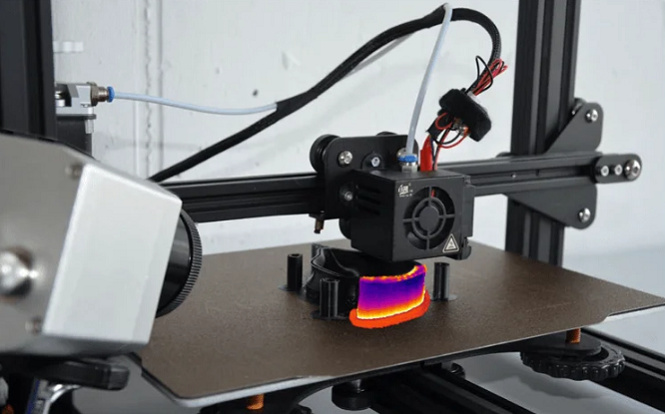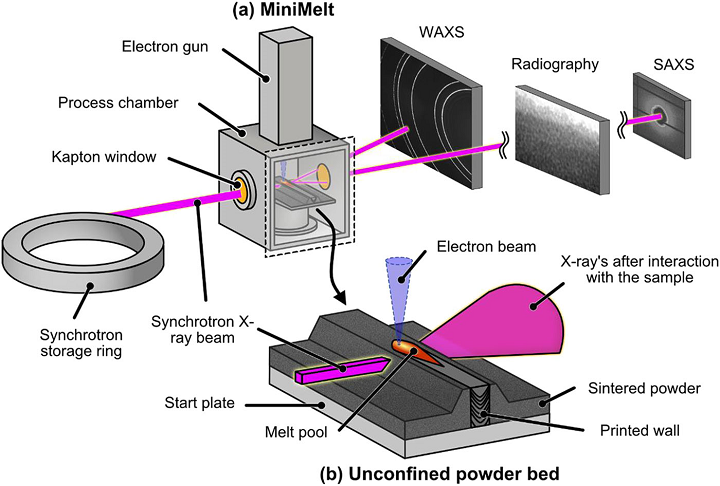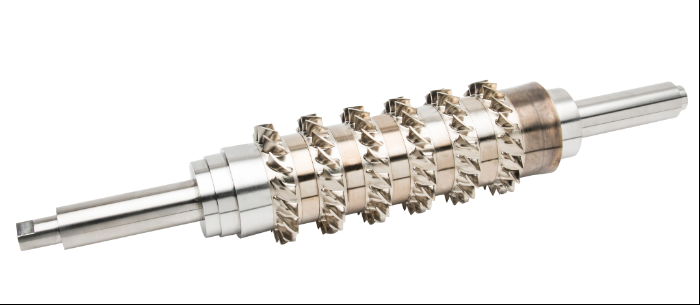In 3D Printing News Briefs, we’re talking about PAEK materials and QA for polymer 3D printing, before moving on to real-time tracking of electron beam additive manufacturing. Upwing Energy integrated Velo3D’s AM process for its patented gas compressor module, decoder-only transformers are generating triangle meshes, and McDonald’s has a 3D printed luminaire. Finally, in medical news, soundwaves are being used to harden 3D printed treatments in deep tissue, and after an amputation, an 84-year-old became the oldest person in the world to get a bionic arm from Open Bionics.
Victrex & University of Exeter Renew PAEK Development Partnership
The University of Exeter and Victrex originally collaborated starting in 2018 to develop next-gen polyaryletherketone (PAEK) 3D printing materials, and the partnership was so successful, they’ve decided to renew it for an additional five years, and will continue to invest together in developing PAEK materials and processes through 2028. Victrex is a global leader in PAEK, while the university’s Centre for Additive Layer Manufacturing (CALM) is the UK center of excellence in high-temperature polymer AM, and has plenty of high-quality AM equipment on-site. Together with the Exeter Technologies Group (ETG), which are experts in high-performance AM polymers, Victrex will work to clarify the science under several PAEK-related processes, including AM.
Driving this continued partnership is the work’s potential high impact, as well as strategic alignment with Victrex’s R&D goals. Several scientific and industrial outcomes have already resulted from their collaboration, including patents, scientific publications, and case studies about the fundamental science of PAEK materials and AM, as well as new PAEK materials tailored specifically for AM and other new collaborative projects. Victrex and the university will now continue to work on funded PAEK research projects with other ecosystem partners, and encourage new proposals for other related collaborations. Hopefully, the results from their continued work will speed up innovations through virtual experimentation and by creating new tailored PAEK polymer solutions.
SKZ & Optris Using Infrared Cameras for 3D Printing QA

Quality control using the Optris PI 640i during 3D printing with the fused filament fabrication method (composite image with IR view and real image). Image Credit: The German Plastics Center – SKZ
There are many parameters that need to be set to ensure a successful FFF 3D print, and defects can pop up quickly. Particularly when printing spare parts with a rapid turnaround, these defects need to be immediately identified, so quality assurance (QA) throughout the process and on the finished component is necessary in industrial applications. One promising QA approach in 3D printing is thermography, as it can be used for whole surfaces and involves no contact. Using an infrared camera, inspection can be easily conducted both during and after printing. The German Plastics Center (SKZ) is partnering with Optris GmbH, which specializes in infrared measurement technology, to optimize QA in 3D printing with thermal imaging cameras.
Optical monitoring processes are most commonly used for 3D printing QA, but they’re not always accurate. So with the compact, high-resolution Optris PI 640i infrared camera, SKZ developed a novel imaging option for inline quality assurance of 3D printing, using both passive and active thermography. The camera can display filament deposition live, while also monitoring process parameters at the same time; this enables typical defects like cracks and delamination to be easily identified. Even during image capture, the thermographic data generated can be analyzed frame by frame, so you can catch issues in the printing process early. Plus, Optris cameras can inspect 3D printed parts in a non-destructive way for damage or functionality once they’re in practical use.
MiniMelt Tracks Electron Beam Powder Bed Fusion in Real Time

(a) Schematic of the PBF-EB experimental setup (MiniMelt) for measurements of Wide-Angle X-ray Scattering (WAXS), radiography, and Small-Angle X-ray Scattering (SAXS) in a synchrotron. (b) Schematic of the unconfined powder bed where the x-ray beam interacts with the sample.
To facilitate alloy and process development for Electron Beam Powder Bed Fusion (PBF-EB) additive manufacturing, it’s important to have a solid understanding of the physics of heating, melting, and solidification cycles. In their paper, a team of researchers from KTH Royal Institute of Technology, Friedrich-Alexander-Universität Erlangen-Nürnberg (FAU), Helmholtz-Zentrum Hereon’s Institute of Materials Physics, DESY Photon Science, and Freemelt AB explain how they designed and developed “MiniMelt: An instrument for real-time tracking of electron beam additive manufacturing using synchrotron x-ray techniques.” MiniMelt is a sample environment for in situ x-ray characterization during PBF-EB 3D printing, and the team implemented it at the German synchrotron facility PETRA III at Deutsches Elektronen-Synchrotron (DESY). Based on the Freemelt ONE, the MiniMelt has a unique process chamber that allows for real-time synchrotron measurements during printing. The team also describe a new unconfined powder bed design, which replicates the conditions of the PBF-EB process.
“The first radiography (15 kHz) and diffraction (1 kHz) measurements of PBF-EB with a hot-work tool steel and a Ni-base superalloy, as well as bulk metal melting with the CMSX-4 alloy, using the sample environment are presented. MiniMelt enables time-resolved investigations of the dynamic phenomena taking place during multi-layer PBF-EB, facilitating process understanding and development of advanced process strategies and materials for PBF-EB,” the researchers wrote.
Upwing Energy Integrates Velo3D’s AM for Gas Compressor Module
Gas tech innovator and service company Upwing Energy has successfully integrated metal AM into its manufacturing process, specifically laser powder bed fusion (LPBF) from Velo3D. Upwing’s patented Subsurface Compressor System (SCS) is used to increase production and recoverability of natural gas from wells, and it uses a multistage hybrid axial compressor to increase drawdown at intake and pressure at discharge. The compressor’s rotor design especially requires very complex surface geometries, but with Velo3D’s metal AM and expertise, Upwing not only achieves this, but can also move from engineering design to full rotor assembly in just 10 weeks to support well deployment schedules. Extensive testing with Velo3D proved that the Inconel 718 3D printed parts maintain high quality and durability.
“All of our work at Upwing is underscored by the belief that continuous improvement is always possible. Our decision to integrate additive manufacturing makes us more scalable and adaptable. It allows us to create parts that are not only durable, but intricately designed and finished with the highest level of precision,” said Robert McKeirnan, Vice President of Supply Chain and External Manufacturing at Upwing Energy.
Automated Triangle Mesh Generation with Decoder-Only Transformers

Figure 6. Qualitative comparison of Chair and Table meshes from ShapeNet (5). Our approach produces compact meshes with sharp geometric details. In contrast, baselines often either miss these details, produce over-triangulated meshes, or output too simplistic shapes.
As opposed to alternative 3D shape representations like voxels or point clouds, meshes are easier to manipulate, more controllable and compact, fit into modern rendering pipelines, and offer a more coherent surface representation. Triangle meshes, in particular, are the main representation in computer graphics for 3D geometry. A team of researchers from Technical University of Munich, Politecnico di Torino, and AUDI AG wrote a paper on “MeshGPT: Generating Triangle Meshes with Decoder-Only Transformers,” about automated generation of triangle meshes to streamline the process of creating 3D assets. The team synthesizes these meshes as sequences of triangles via a direct sequence generation method.
“We introduce MeshGPT, a new approach for generating triangle meshes that reflects the compactness typical of artist-created meshes, in contrast to dense triangle meshes extracted by iso-surfacing methods from neural fields. Inspired by recent advances in powerful large language models, we adopt a sequence-based approach to autoregressively generate triangle meshes as sequences of triangles. We first learn a vocabulary of latent quantized embeddings, using graph convolutions, which inform these embeddings of the local mesh geometry and topology. These embeddings are sequenced and decoded into triangles by a decoder, ensuring that they can effectively reconstruct the mesh. A transformer is then trained on this learned vocabulary to predict the index of the next embedding given previous embeddings. Once trained, our model can be autoregressively sampled to generate new triangle meshes, directly generating compact meshes with sharp edges, more closely imitating the efficient triangulation patterns of human-crafted meshes. MeshGPT demonstrates a notable improvement over state of the art mesh generation methods, with a 9% increase in shape coverage and a 30-point enhancement in FID scores across various categories,” they wrote in their abstract.
Cooper Lighting Solutions 3D Prints Custom Light for McDonald’s
McDonald’s Corp. needed pendant designs for new stores, but an off-the-shelf design was impossible—they wanted a scalable solution, short lead time, competitive cost, and to own the IP rights. The company worked with Cooper Lighting Solutions, which was acquired by Signify in 2020, to design a 3D printed, semispherical luminaire with an embossed pattern. During the consultation and design process, the client and designers had several conversations, and Cooper Lighting had a 3D printed sample product ready in three months. After three more months of hashing out the details, McDonald’s gave its final approval for the custom luminaire, which Signify’s Phillips Lighting team printed out of a polycarbonate material custom-built for its products. The fixture’s surface has raised patterns and lines to shape the light, and the luminaire is durable, easy to clean, recyclable, and doesn’t yellow with age, which were all factors McDonald’s wanted. Plus, because Signify has 3D printing facilities all over the world, local manufacturing is possible.
“The whole fixture is done in one print; it doesn’t stop, there are no breaks, the printing just slows down a little, thickens up the polycarbonate, and creates that line so that light doesn’t penetrate,” explained Lawrence Fallon, Business Development Manager, Prentalux, Cooper Lighting Solutions. “It was something McDonald’s had never seen able to be done on a single-piece fixture. A lot of manufacturers could’ve added paint, or they could’ve added a basket over it or hung something over a glass fixture to create that type of look, but the fact that we were able to print it right into the fixture was very unique.”
Ultrasound Waves Harden 3D Printed Treatments in Deep Tissues

The printing process of DVAP can close the left atrial appendage within minutes. The thermal image shows the temperature rise during the printing. Image credit: Junjie Yao, Duke University; Shrike Yu Zhang, Harvard Medical School.
Over the years, researchers developed a photo-sensitive ink for medical 3D printing that responds directly to targeted beams of light, hardening quickly into the final structure. But, researchers can only use transparent inks, which limits biomedical applications, as light can’t reach past just a few millimeters into tissue. Now, engineers at Duke University and Harvard Medical School have created a biocompatible ink that solidifies into different biologically compatible 3D shapes and structures when it’s exposed to and absorbs ultrasound waves. Plus, since it responds to sound waves and not light, the viscous ink can be used in deep tissues for biomedical purposes including bone healing and heart valve repair. The method is called deep-penetrating acoustic volumetric printing, or DVAP, and starts with a sonicated ink, or sono-ink, made of hydrogels, microparticles, and molecules designed to react to ultrasound waves. Once it’s delivered, a special printing probe sends ultrasound waves into the ink, which hardens portions into structures. The team successfully conducted three tests as a proof-of-concept of their new DVAP method.
“DVAP relies on the sono-thermal effect, which occurs when soundwaves are absorbed and increase the temperature to harden our ink. Ultrasound waves can penetrate more than 100 times deeper than light while still spatially confined, so we can reach tissues, bones and organs with high spatial precision that haven’t been reachable with light-based printing methods,” explained Junjie Yao, associate professor of biomedical engineering at Duke, who designed the ultrasound printing technology for DVAP.
“Because we can print through tissue, it allows for a lot of potential applications in surgery and therapy that traditionally involve very invasive and disruptive methods. This work opens up an exciting new avenue in the 3D printing world, and we’re excited to explore the potential of this tool together.”
Grandmother Becomes World’s Oldest Person to Get a Bionic Hero Arm
84-year-old Christa Seubert from Würzburg, Germany is the oldest person in the world to be fitted with a 3D printed bionic Hero Arm from Open Bionics. After first thinking she had a blocked carpal tunnel, it became clear that Seubert had an aggressive cancer. Chemotherapy failed, and her right arm was amputated to save her life. But she’s very active and enjoys gardening, cycling, crafting, and walking her dog, and found it hard to get back to doing everyday activities, like buttering bread, on her own. She needed a lightweight prosthesis, and within one hour of fitting, Seubert was able to use her new Hero Arm to walk her dog. Open Bionics, founded in 2014, works to develop affordable, assistive devices that can help turn disabilities into superpowers. Its Hero Arm uses myoelectric sensors to detect the underlying muscular contractions generated from the arm’s specific muscle groups, and amplifies and converts them to proportional, intuitive bionic hand movements. 3D scanning and printing ensure that each bionic arm is customized for its user.
“For Christa, being fitted with a Hero Arm has big advantages. It’s the ease of use, the very low weight compared to other prosthetic fittings, and the ease of putting on and taking off that I think will allow her to enjoy her independence,” said Mathias Stegemann, CPO at APT Prothesen in Würzburg, who fitted Seubert for her bionic arm.
Subscribe to Our Email Newsletter
Stay up-to-date on all the latest news from the 3D printing industry and receive information and offers from third party vendors.
You May Also Like
Gorilla Sports GE’s First 3D Printed Titanium Cast
How do you help a gorilla with a broken arm? Sounds like the start of a bad joke a zookeeper might tell, but it’s an actual dilemma recently faced by...
Nylon 3D Printed Parts Made More Functional with Coatings & Colors
Parts 3D printed from polyamide (PA, Nylon) 12 using powder bed fusion (PBF) are a mainstay in the additive manufacturing (AM) industry. While post-finishing processes have improved the porosity of...
$25M to Back Sintavia’s Largest Expansion of Metal 3D Printing Capacity Since 2019
Sintavia, the digital manufacturing company specializing in mission-critical parts for strategic sectors, announced a $25 million investment to increase its production capacity, the largest expansion to its operations since 2019....
Velo3D Initiates Public Offering in a Bid to Strengthen Financial Foundations and Drive Future Growth
Velo3D (NYSE: VLD) has been among a number of publicly traded 3D printing firms that have attempted to weather the current macroeconomic climate. After posting a challenging financial report for 2023,...



































